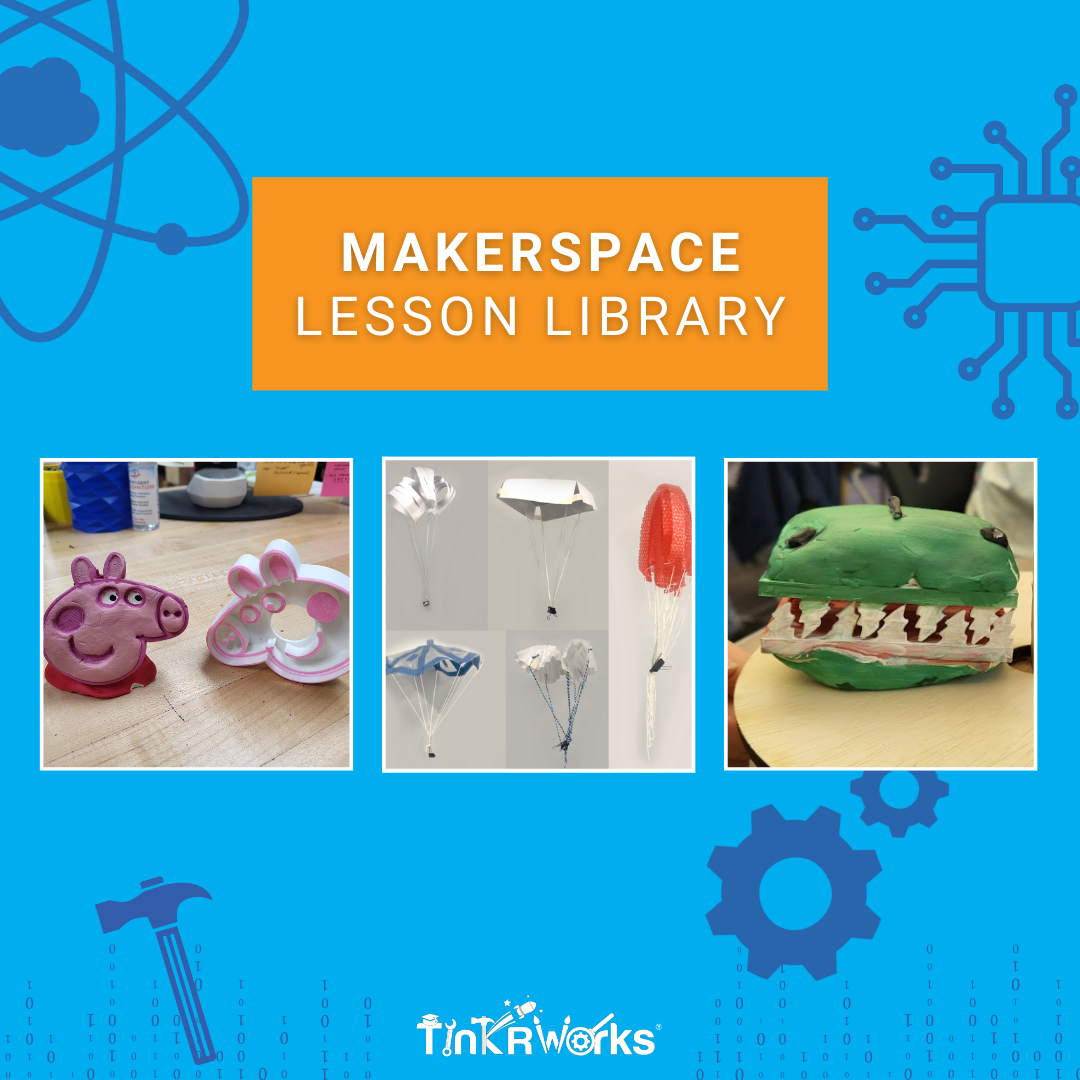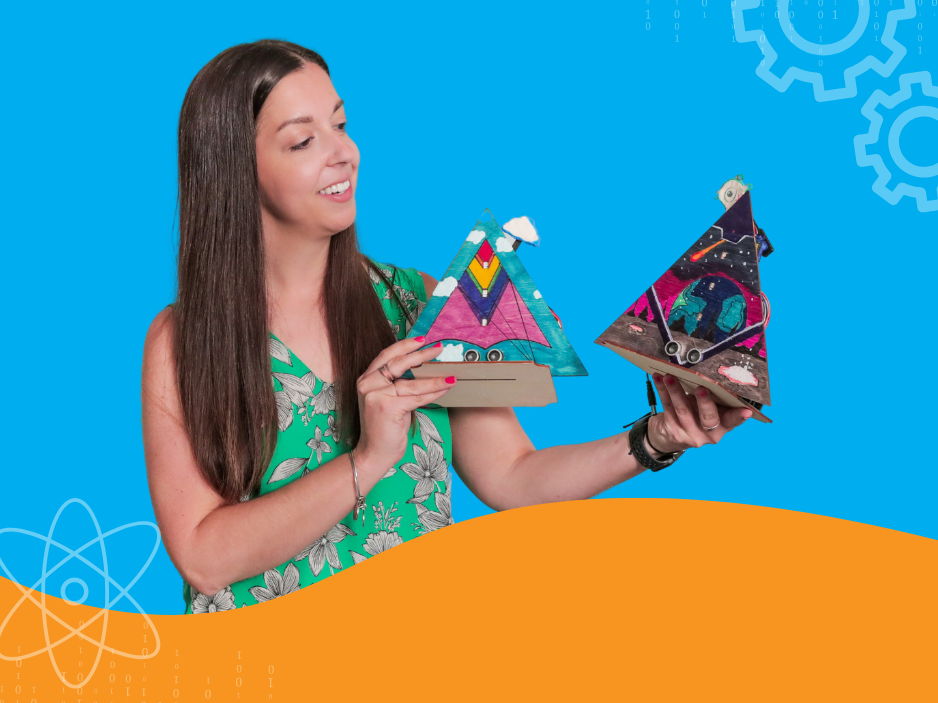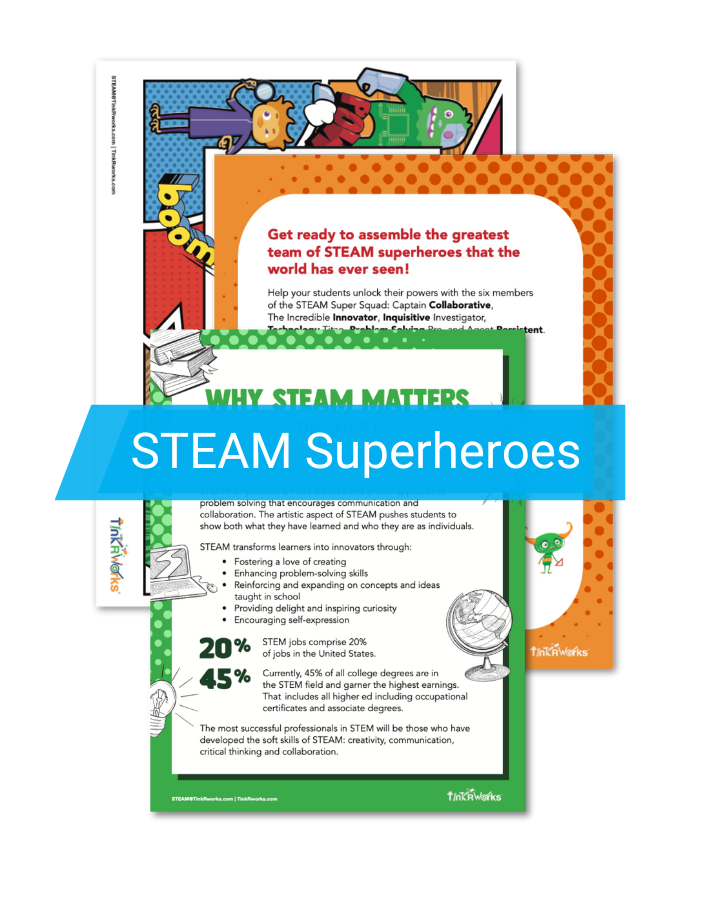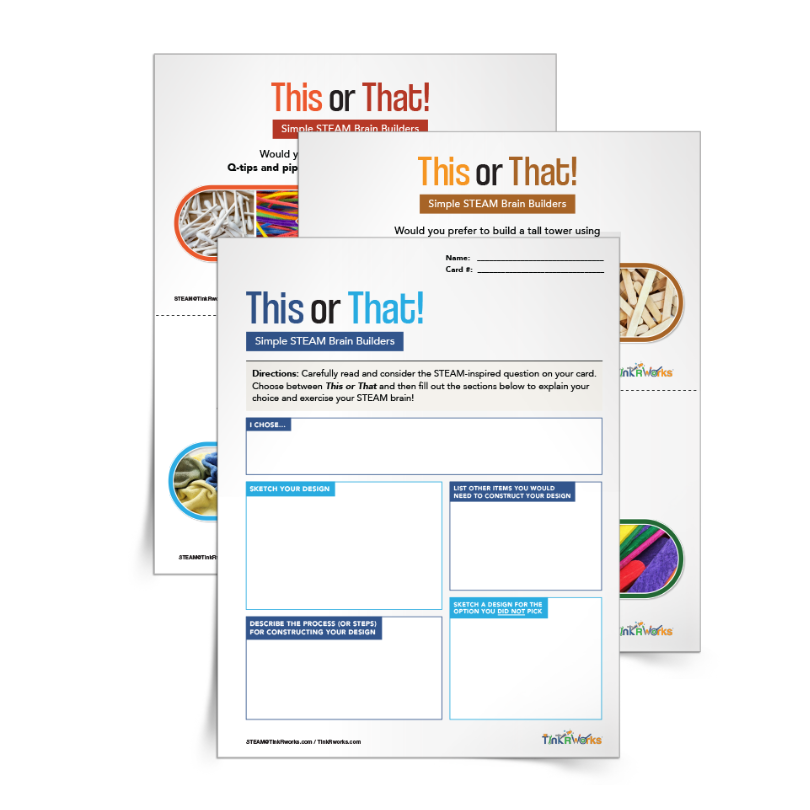The benefits of STEM education are clear: Studies show that the average STEM student academically outperforms approximately 70% of their same-age, same-grade peers not participating in STEM programming. Integrating the arts into this approach through STEAM curriculum and projects connects with even more students’ interests and helps cultivate more comprehensive skill sets. Equipped with the skills and knowledge learned in K-12 STEM and STEAM programs, students are more likely to pursue STEM disciplines in college and their future careers.
STEAM Superheroes Kit: Introduce students to six essential STEAM skills with our STEAM Superheroes Kit. The kit includes posters, banners, and a teaching tip sheet, all designed to inspire students and guide your instruction.
This or That Simple STEAM Brain Builders: These quick brain-building STEAM activities, perfect for elementary students, are ideal for starting class or refocusing between projects. They encourage critical thinking and provide insight into students’ analytical skills.
STEM Makerspace Library: Our TinkRpedia library offers free, classroom-tested makerspace lessons that use accessible and recycled materials. Browse a wide range of STEAM lesson ideas to implement engaging STEAM activities in your classroom.
All these activities and more are available on our STEAM Activities and Resources page. Explore these tools to enhance your STEM education efforts and inspire your students!
STEM Education in Elementary Schools Impacts Academic Performance
Surveys show that up to 82% of current STEM professionals developed their interest in STEM before high school. Yet, only 17% of K-3 classrooms study science all or most days of the week. Even in late elementary and middle school grades, students experience gaps in their STEM education. Often only receiving access to traditional science and math courses rather than more specialized courses focused on engineering and technology. These instructional gaps are even larger among students from lower socioeconomic backgrounds and students in special education programs. In order for students to gain the benefits that STEM education has to offer, they must be provided with access to STEM and STEAM programs throughout their educational journey. With this in mind, it’s important for schools to implement STEM programs that introduce students to STEM early, ensuring opportunities are abundant for all students.5 Benefits of Introducing STEM Education in Elementary Schools

1. Nurture young learners’ interests
In order for children to discover their interests in STEM subjects, it’s crucial that they receive frequent STEM learning experiences. Introducing students to STEM at an early age creates more opportunities for them to explore and develop their interests in these fields. Early exposure to STEM education can ignite learners’ passions for subjects like robotics or engineering, leading them to potential college majors and careers in the future. Consistent engagement in quality STEM instruction that aligns with students’ interests is an important part of cultivating learners’ lifelong interest in STEM.2. Develop critical thinking and problem-solving skills
STEM education is often inquiry-based. It emphasizes the importance of asking questions, testing hypotheses, and discovering solutions. This approach encourages learners to develop and use a broad skill set, including critical thinking and problem-solving. Furthermore, interactive project-based STEAM instruction can strengthen students’ executive functioning abilities. This includes time management, organization, working memory, attention and self-control. Practicing these skills at an early age is beneficial to learners in the classroom and beyond, equipping them with the tools to process complex challenges and solve problems.3. Support interdisciplinary learning
Through an interdisciplinary approach to STEAM, learners are able to experience a more holistic education. The skills and knowledge learned in STEAM activities translate to a variety of disciplines, including language arts, social studies, and the arts. Particularly through an experiential and project-based learning approach, students are required to tap into many different skills, including design, planning, language and writing, and presenting. Learning how to connect and combine these skills nurtures learners’ creativity and innovation, promoting engagement and academic achievement. Furthermore, STEM education helps students learn how to use technology effectively. This is a crucial skill for success in today’s technology-driven world.4. Promote social and emotional learning learning
Introducing students to STEM early through hands-on and project-based learning opportunities can promote positive social and emotional development. Project-based learning not only improves student outcomes, but is also associated with positive social development. In project-based STEAM initiatives, students cultivate decision-making skills and learn how to communicate and demonstrate what they are learning. It is also common for STEM curriculum to include collaborative activities, in which students learn to engage with their peers and effectively solve problems as a team. This approach fosters community and communication, teaching students important interpersonal skills that they will use far beyond the classroom.5. Boost students’ confidence
After participating in STEAM programming at school, students reported an increased desire to build and create and an increased comfort level with technology, one TinkRworks impact study found. Project-based STEAM curriculum can teach students to embrace challenge, develop determination, and celebrate their personal achievements. Giving learners opportunities to succeed in STEM disciplines can lead to positive attitude and behavior shifts, boosting self-confidence. Students who are confident in their science and math abilities are more inclined to continue pursuing these disciplines through middle and high school, college, and beyond.Activities & Resources to Support STEM Education in Elementary Schools
Supporting STEM education in elementary schools requires engaging activities and valuable resources that spark curiosity and foster creativity. At TinkRworks, we offer a variety of tools to help educators bring STEM and STEAM learning to life.STEAM Superheroes Kit: Introduce students to six essential STEAM skills with our STEAM Superheroes Kit. The kit includes posters, banners, and a teaching tip sheet, all designed to inspire students and guide your instruction.
This or That Simple STEAM Brain Builders: These quick brain-building STEAM activities, perfect for elementary students, are ideal for starting class or refocusing between projects. They encourage critical thinking and provide insight into students’ analytical skills.
STEM Makerspace Library: Our TinkRpedia library offers free, classroom-tested makerspace lessons that use accessible and recycled materials. Browse a wide range of STEAM lesson ideas to implement engaging STEAM activities in your classroom.

All these activities and more are available on our STEAM Activities and Resources page. Explore these tools to enhance your STEM education efforts and inspire your students!
STEM Curriculum for Elementary School
At TinkRworks, we’re committed to offering engaging STEM curriculum for elementary schools that fosters academic success. Our standards-rich projects introduce STEM concepts as early as kindergarten, providing a strong foundation for future learning. Through our innovative STEAM programs, we inspire continuous curiosity, promoting a lifelong mindset of inquiry and problem-solving. We’re proud of our STEAM projects, which span various grade levels and concepts, introducing students to the creativity in STEAM learning. Projects like Tech-A-Sketch, LaunchPad and Art Electric inspire future innovators. Interested in exploring our STEM curriculum further? Check out our hands-on projects here!In Conclusion
STEM education equips learners with essential skills and knowledge, guiding them toward future career opportunities. In a survey, 62% of students aged 12-18 expressed interest in STEM careers, yet nearly 60% of students lose interest by graduation. By nurturing a passion for STEM early on, we can help change this trend. Let’s work together to boost confidence in young learners, especially those from minority groups and those facing socioeconomic barriers to STEM education, ensuring they too can become successful STEM professionals.




